Living in the Suburbs
Twelve of Indiana's 20 largest cities have lost residents since Census 2000, according to the latest population estimates for 2005 (see Table 1). Of course, don't make the mistake of thinking everyone is packing up and moving to Fishers. More often than not, Hoosiers are merely living outside the city limits in nearby suburbs or unincorporated areas within the county.
Speaking of Fishers, the Hamilton County town grew an astounding 50.8 percent, adding almost 19,300 people since 2000. That's like having the entire population of Logansport relocate to the area during the five-year period. Six of the eight large cities that have grown since the start of the decade, including Fishers, are in the Indianapolis metro area (the two exceptions being Mishawaka and Columbus).
Table 1: Population Change in Indiana's Twenty Largest Cities, 2000 to 2005
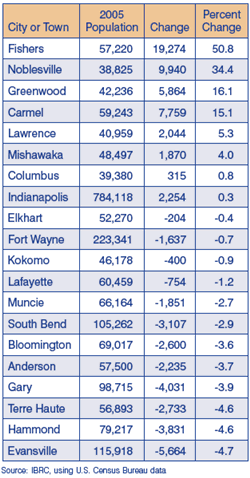
Note that when population change is discussed in this article, it uses the Census 2000 estimates base, which takes into account annexations and other changes in city and town boundaries, so that true population change (be it migration or natural increase) in the area is measured.
Around Indiana's Largest Cities
Figure 1 shows the state's largest cities, each with a 15-mile radius to better highlight their suburbs. The dots display all of Indiana's incorporated places, indicating their change in population since Census 2000. One can clearly see the continuing suburbanization trend in the Indianapolis area, but it's happening elsewhere as well. For example, while the cities of Gary and Hammond lost a combined 7,862 residents, the suburbs within a 15-mile radius had a net gain of 18,470 residents.
Figure 1: Percent Change in Population in Indiana's Incorporated Places, 2000 to 2005
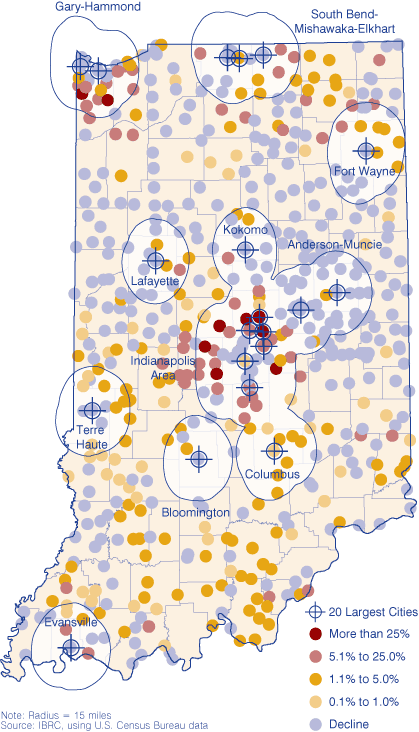
On the other hand, suburbs within a 15-mile radius of Terre Haute, Anderson–Muncie, Kokomo and Lafayette, each had a net decrease in residents, ranging from -69 for Terre Haute to -362 in Lafayette. The Anderson–Muncie region had the most suburbs (36 out of 44) with a declining population.
Of course, it is misleading to look only at incorporated places because many people are living in unincorporated regions of the state (see Figure 2). Take Bloomington, for example: Its six incorporated suburbs lie to the northeast, and combined they had a net gain of about 160 residents. However, looking at population change by township shows that the six townships just south of Bloomington added 1,185 residents and the four townships to the east added 867. And even in the northeast where the suburbs are, one sees people moving to the unincorporated areas near Ellettsville and Stinesville rather than inside the town limits themselves.
Figure 2: Percent Change in Population by Township, 2000 to 2005
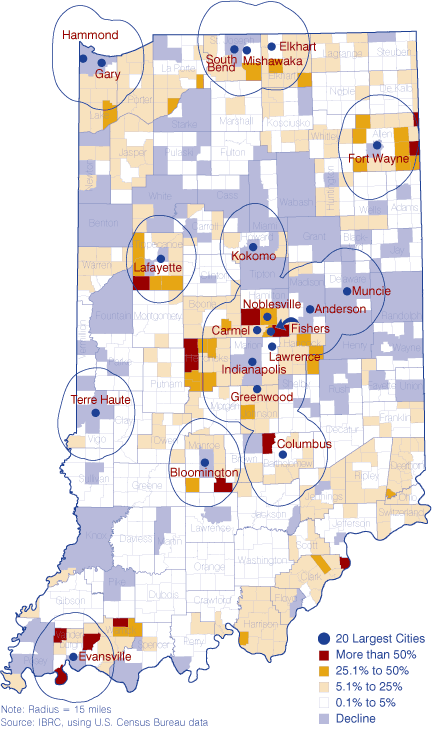
Inside Indiana's Metros
Does the picture change when looking at the metropolitan statistical area definitions? Not really (see Figure 3). In most cases, townships containing central cities are declining, while outlying townships are growing. The Elkhart–Goshen and Columbus metros, along with the Indiana portion of the Cincinnati–Middletown metro, are notable in that all townships experienced growth between 2000 and 2005. Anderson and Muncie are noteworthy exceptions in the other direction, with significant population losses across townships.
Figure 3: Population Change by Township for Metros, 2000–2005
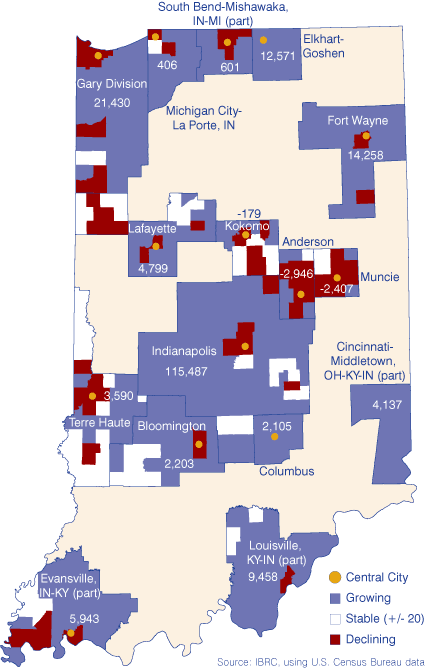
Outside Indiana's Metros
Figure 4 shows the population change for the nonmetro portion of the state, along with the 10 largest nonmetro cities. East of Seymour, all but a handful of townships grew. The same can be said of northeast Indiana and, to a lesser degree, southwest Indiana. Other areas of the state were largely mixed between stability and population losses.
Figure 4: Population Change by Township for Nonmetros, 2000 to 2005
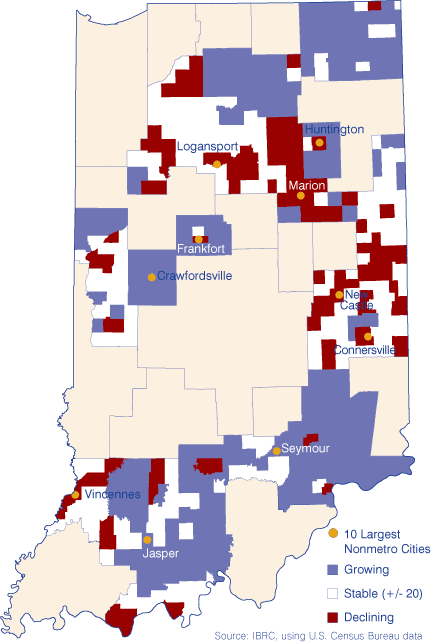
For related discussion on this topic, see the summer issue of the Indiana Business Review at www.ibrc.indiana.edu/ibr.
Rachel Justis, Managing Editor and Geodemographic Analyst
Indiana
Business Research Center, Kelley School of Business, Indiana University
